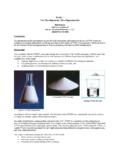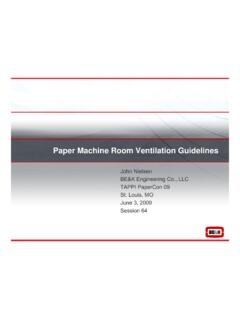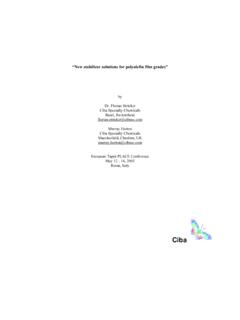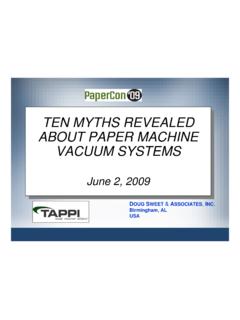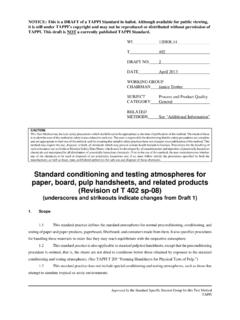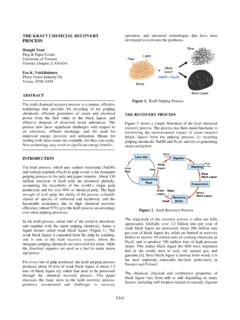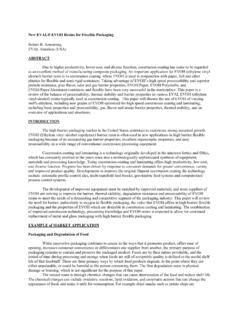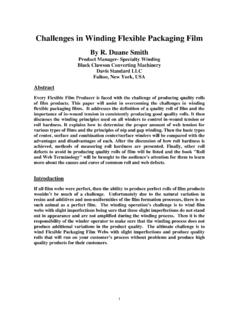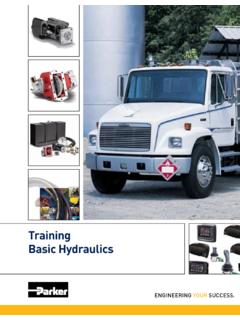Transcription of Troubleshooting and Preventive Maintenance of Hydraulic ...
1 Troubleshooting and Preventive Maintenance of Hydraulic Systems Learning to Read the Signs of Future System FailuresInstructed by:Al Smiley & Alan DellingerCopyright, 2005 GPM Hydraulic Consulting, PumpsFixed Displacement PumpsThe GPMof the fixed displacement pump can not be PumpRelief Valves and Fixed Displacement Pumps Provides a flow pathfor the pump volume back to tank Limits the maximum system pressureRelief ValveSetting the Relief Valve in a Fixed Displacement Pump Circuit Observe the pressure while operating. Open allflow controlsand isolate anyaccumulators. Set the relief valve200 PSIabove the maximum operating pressure Close the Hand Valve.
2 Adjust the relief to1200 PSI. (For this example) Turn the system off, open the hand valve and remove the the Relief Valve in a Fixed Displacement Pump CircuitTroubleshooting Fixed Displacement Pump CircuitsSound ChecksCavitationis the formation and collapse of air cavities in the pump that is cavitating will put out areduced flowuntil it destroys is caused by: Oil viscositytoo high Plugged suction filter Electric motorRPMtoo highAerationAeration occurs when outsideair enters the suctionsideof the pump. Aeration is caused by: Air leakin the suction line Bad shaft sealon a fixed displacement pump Fluid leveltoo low Improper Installation: Coupling is not properlyaligned Wrong shaftrotationChecking the Fixed Displacement Pump Check the pump housing for heat Check thecurrent drawon the electric drive motorHP= GPMX PSI X.
3 000583If the pump is bypassing and the GPM output is lower, then the drive motor scurrent drawwill also be lowerChecking the Fixed Displacement Pump Through the Relief Valve Turn the relief valve CCW and observe the flow Gradually turn the relief CW and observe the flowVariable Displacement Pumps Variable Displacement Pumps are used when thevolume requirementschange in the systemPressure Compensating Piston PumpPressure Compensating Piston PumpCompensatorCase DrainPressure Compensating Piston PumpPump CompensatorSpoolSpringCase DrainNormal bypassing is1-3%of the total pump volume. Most Variable Displacement Pumps have anexternal case drainpiped directly back to Compensating Piston PumpCase Drain Flow Method #1 There are two methods of checking case drain flow: Run the case drain flow into a container of known size and time itCase Drain Flow Method #2 A flow metermay be permanently installed in the case drain Drain Line CoolerPressure Compensating Piston PumpPressure Compensating Pump ExamplePressure Compensating Pump ExamplePressure Compensating Pump ExampleSystems With Relief ValvesThe purposes of a relief valve in a pressure compensating pump system are.
4 Absorb pressure spikes Operate as an extreme safety deviceThe only time the relief valve should open is when the pressure rises above the compensator Procedure Observe the system to find the maximum operating pressure Establish a deadhead condition Turn the relief valve fully CCW Turn the compensator fully CW Turn the relief valve CW to 1450 PSI Turn the compensator to 1200 PSIA djustment ProcedureRelief Set Below Compensator If the relief valve is set below the compensator, the pump will act as a fixed displacement will be generated!Calculating Heat & Electrical Power HP = GPM X PSI X .000583= 30X 1450X.
5 000583= 25 HP 746 Watts = 1 HorsepowerElectrical Power =746X 25= 18,650 WattsAccumulatorsHydraulic accumulators are used to store pressurized fluidBladder AccumulatorPiston AccumulatorPiston AccumulatorAccumulators Supply additional oil flow to the system at a very fast rate Absorb shockAccumulators are used for ONEof two purposes depending upon the PRECHARGEA ccumulatorsDry Nitrogen is used to precharge the top portion of an accumulator1% Argon and other gases21% Oxygen78% NitrogenAccumulatorsNEVERuse OxygenorCompressed Airto precharge an accumulator!Rule of Thumb- Precharge to one-half of the maximum system pressure1000 PSIP recharge2000 PSIC ompensator Setting0 PSIS ystem Pressure12 Using the Charging RigGaugeGas Chuck HandleBleeder ValveNitrogen Bottle ConnectionChecking the Precharge HydraulicallyPump turned offDump Valve Closed2000 PSI2000 PSIP ressure Locked in SystemChecking the Precharge HydraulicallyDump Valve OpenPressure slowly drops to precharge, then immediately to 0 PSIT ypes of AccumulatorsPiston AccumulatorsExample Circuit1000 PSI1/4 Dump Valve (Open when the power is turned off)2000 PSII solation ValveExample Circuit2000 PSI1/4 Dump Valve (Closed)
6 2000 PSII solation Valve2000 PSIP ower OnExample Circuit1/4 Dump Valve (Closed)2000 PSII solation Valve1800 PSIE xtend CylinderChecking the Piston Accumulator2000 PSI2000 PSIS ystem pressure should build to the compensator setting whenever actuators are not cycling1800 PSIC hecking the Piston AccumulatorSystem pressure should not drop more than 100-200 PSI when the directional valve opensChecking the Piston AccumulatorPiston TravelHeat should be felt from here to here:Checking the Piston Accumulator1000 PSI100 PSID ropping to a very LOW pressure usually indicates an accumulator problemOverchargedHeatPiston MovementOverchargedOil Bypasses Around PistonPiston Removal321 With the pump on.
7 Open the #3 bleeder valve on the charging rig Close the #1 isolation valve Open the #2 manual dump valve Remove the charging rig and the top of the accumulator UnderchargedLeak Paths for NitrogenUnderchargedHeatHydraulic pressure drives piston near the topPoppet ValveBladder AccumulatorBladder AccumulatorPoppet ValvePoppet ValveBladder AccumulatorBladder AccumulatorPoppet ValveHeat should be felt between these two pointsChecking The Bladder AccumulatorIf noheat is felt on the bladder accumulator, then one of two things has happened: The precharge is abovethe maximum system pressure The bladder is ruptured The nitrogen has leaked out of the bladderChecking The Bladder AccumulatorANYcircuit using an accumulator MUST have some method of bleeding the pressure down when the system is turned offPriorto working on the system, you should VERIFY that the pressure is bled down by observing the gaugeAccumulator Dump ValvesManual Dump ValveSolenoid Operated Dump ValveTolerances In Components Tolerances in Hydraulic pumps and valves: 5 - 8 microns(.)
8 0002 - .0003 ) Tolerances inside servo valves: 3 microns(.0001 )Sources of ContaminationNew oilleaving the refinery is relatively cleanBy the time it reaches your mill it meets a 50 -200micron standardOil should always be filteredprior to entering the reservoirBuilt In Contamination Metal Chips Dirt Sand Pipe Sealant Burrs Dust Weld Splatter PaintWhen a system is first built and installed, contamination may be in the form of:Ingressed Contamination Breather Cap Access Plates Hose and Component Replacement Cylinder SealsThere are four ways contamination can enter the system from the outside:Fluid SamplingThe biggest problem in Hydraulic systems isCONTAMINATIONThe key to controlling it is through an effective fluid samplingand filter maintenanceprogramSample BottleOil AnalysisThe size and number of particles taken from 1ml of the sample are measured by a particle counterISO Cleanliness CodeRecommended Servo Level is 14/11 System 1 passeswith a level of 13/11 System 2 failswith a level of 16/14 Filter SelectionFilters are selected by a Betarating - the ratio of the number of particles upstreamof the filter versus the number of particles downstream of a specific sizeFluid entering and fluid leaving the filter is
9 Measured with a particle counterBeta Rating2 3m particles in1 3m particle out 3= 2 Beta Rating75 10m particles in1 10m particle out 10= 75 Hydraulic systems require a beta rating of 75to EfficientFilter PlacementThere are primarily three locationsfor filters in the system (other than the suction strainer): Pressure Line Separate Recirculating System Return LinePressure Line FilterUpstream of ANYS ervo ValvePressure Line FilterDownstream of a Fixed Displacement Pump operating at pressures exceeding 2250 PSIP ressure Line FilterDownstream of a Variable Displacement Pump operating at pressures exceeding 1500 PSIR eturn Line FilterSeparate Recirculating SystemLeakage ControlProblems with leaks: Expensive-at $ a gallon, one leak that drips one drop per second will cost.
10 $ day $102a month $1225a year Unsafe- dangerous conditions Environmentally Hazardous- EPA setting stricter standards and penaltiesCauses of Leaks Use the proper scheduleof pipe Schedule 40for suctionand returnlines Schedule 80or 160for pressurelines Apply sealantproperlyThe main reason Hydraulic systems leak is because of a bad installationProper Clamping5 5 6 HoseSocket Weld FlangesPIPEWeldO-RingHose Installation Proper Crimping Proper Length Protective SleevesDrain LinesCase drain lines should be piped directly back to tankBelow Fluid LevelOther Causes of Leaks Pressure settings and shock- pressures set too high result in excess force.
